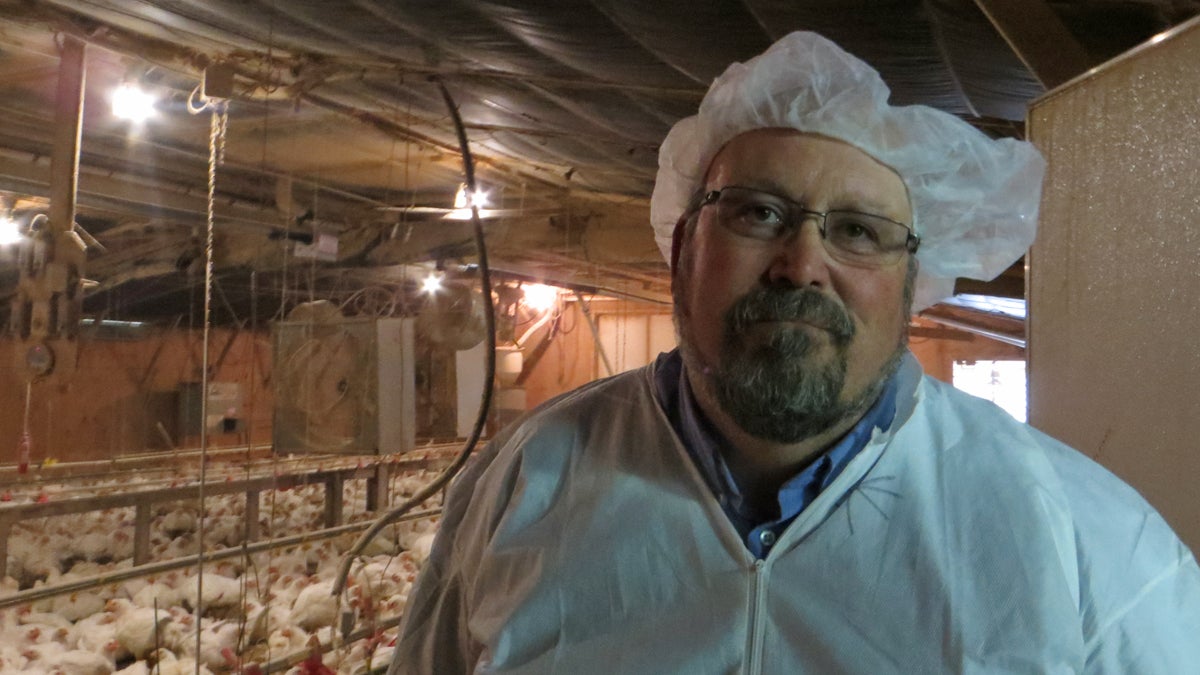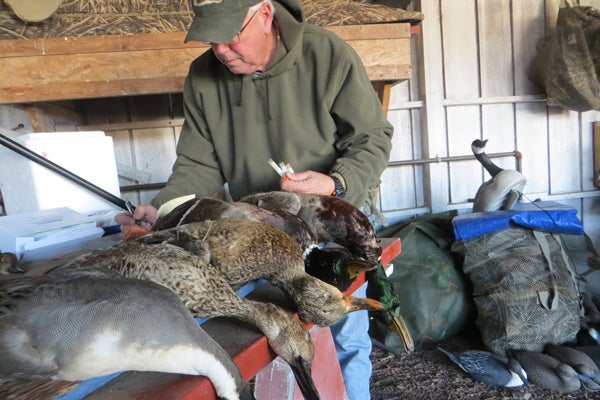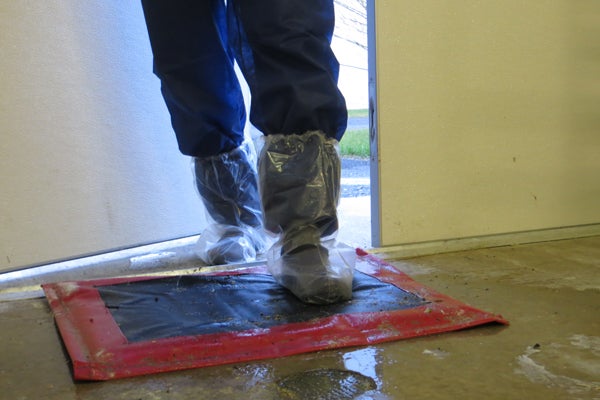East Coast poultry producers are on the hunt for bird flu
Listen
University of Delaware Agricultural Extension Agent Bill Brown says asking farm visitors to wear protective personal equipment is part of Delmarva’s biosecurity plan to protect the poultry industry from highly pathogenic avian influenza. (Taunya English/WHYY)
East coast poultry growers dodged the virus last year and they’re on high alert again.
An outbreak of highly pathogenic avian influenza in Indiana is the first sign of the bird flu in the United States since June last year.
Officials don’t expect any human health concerns, but ten commercial flocks in Indiana will be destroyed to stop the spread of the disease among poultry.
Producers all over the country are worried again. The virus strain detected in Indiana is different from those that swept through flocks in 2015, but the threat to domestic birds is the same.
On the East Coast, Maryland, Delaware and Virginia are a hub of the poultry industry—and many farmers predicted that the bird flu would arrive there this fall.
“I thought it was inevitable but thus far we haven’t found it in our sampling, it’s a good thing,” said Larry Hindman, a wildlife biologist with the Maryland Department of Natural Resources, who recently retired.
“No dead chickens, no dead turkeys or effect on the local economy.”
It was migrating wild birds that first brought deadly avian influenza to the U.S. in 2015.
The government’s plan to protect commercial birds starts with monitoring those wild birds. Waterfowl set down on wetlands–-defecate, drool—and generally spread their germs around. Dabbling ducks—which feed on the surface of ponds—routinely carry bird flu but often don’t show any symptoms.
“When we are looking for the needle in the haystacks–the highly pathogenic avian influenza virus–we want to look in the right haystack,” Hindman said. “Dabbling ducks is the group we are targeting.”
Maryland is part of a federal effort to test thousands of birds such as mallards, black ducks and green-winged teals. The government is gathering DNA samples from dead birds bagged by hunters—like Hindman.
After spending a December morning duck hunting on the Eastern Shore, Hindman spent the rest of the day working—meeting up with other hunters and their dogs—hoping to find dabbling ducks to test.
In the east, there are no signs of the bird flu that kills domestic birds, still, agriculture experts have stepped up biosecurity—just in case. Every producer is supposed to have a plan to keep infectious disease off the farm. And those plans are part of a national system. One of the security checkpoints in that system is at Pennsylvania State University’s animal diagnostic lab.
 Biologists with the Maryland Department of Natural Resources are gathering DNA samples from birds downed by hunters. Monitoring wild birds for high path bird flu is an early warning system for the poultry industry. (Taunya English/WHYY)
Biologists with the Maryland Department of Natural Resources are gathering DNA samples from birds downed by hunters. Monitoring wild birds for high path bird flu is an early warning system for the poultry industry. (Taunya English/WHYY)
Professor Mike Hulet wants to show off the birds his team is raising, but you can’t get into any chicken house these days without first disinfecting your boots and putting on paper pajamas—a suit of protective clothing—plus boot covers, a hairnet and gloves.
The agricultural school grows research hens, roosters and the kind of broiler chickens that end up on the dinner table.
“We’re trying to make a good product and help feed the world,” Hulet said.
Lethargy, nasal discharge, coughing and sneezing can mean a bird is sick, but high path bird flu is so fast-acting and contagious, farmers can miss those signs, he said.
“One of the biggest symptoms that they had was mortality, that was the first thing they found out in Minnesota and Iowa [in 2015],” said Hulet.
Before Pennsylvania companies send their meat birds to market, they send saliva and blood samples to Penn State for testing.
A throat swab lets the scientists look for live, active virus. The blood test can detect antibodies left behind as a disease works its way through the body. And that gives veterinarians a snapshot of illness circulating in an animal five or 10 days ago.
“What happens is–a chicken becomes a virus factory,” said Bill Brown, an extension agent with the University of Delaware.
Brown grows his own chickens and teaches new agricultural practices to family farmers. He also reminds them about biosecurity. Unless you have essential business on the farm, farmers prefer that you kindly keep out.
“Absolutely no visitors,” he said.
Brown works on Delmarva—a peninsula made up from portions of Delaware, Maryland and Virginia. It’s a tiny place but the poultry industry is huge.
Brown says it only takes one mistake–and a bit of infected chicken poop on your shoe to move bird flu from one farm to the next. The chickens leave behind virus in the dust and dander—and it gets onto farm equipment and people. It can also move through the air on the wind.
Brown said for farmers, the five absolutes of poultry biosecurity are:
Avoid backyard flocks, live bird markets and exotic pets
Require workers to use farm-designated shoes and clothing
Restrict visitors
Require visitors to wear protective personal equipment
Handle and dispose of dead birds properly
 With producers on alert for bird flu, you can’t get into any chicken house these days without first disinfecting your boots and putting on protective clothing. (Taunya English/WHYY)
With producers on alert for bird flu, you can’t get into any chicken house these days without first disinfecting your boots and putting on protective clothing. (Taunya English/WHYY)
Those are the rules at Charles Postles farm in Milford, Delaware. He and other family famers contract with big companies like Tyson Foods and Purdue. In December, he had about 90,000 roaster chickens just about ready to go to market. And he wasn’t taking any chances.
“You see how many chicken houses you’ve seen going up and down the road,” Postles said. “Because of the concentration of poultry producers in Delaware, Postles says the region is ready to respond if there’s a local outbreak.
“We’re prepared, trying to be as prepared as we can,” he said.
There is no vaccine and no medicine to cure high-path avian influenza. If biosecurity doesn’t work, de-population is the primary way to stop the disease. That’s what happened last year when 48 million birds had to be killed in the Midwest.
Across Delmarva, Postles says there are four de-population machines on standby for the region.
“It just makes a foam layer about three feet deep, and it euthanizes the chickens, it’s very quick and then the birds are composted within the house, then they cook, that composting raises the temperature to usually over 140 degrees, that kills the pathogens,” Postles said.
After birds are destroyed, a farm operation has to sit empty for weeks. That’s big money on the line, so farmers have lots of incentive to be safe.
“We’re not out of the woods until March, there’s a lot of opportunity for this thing to explode,” Postles said.
WHYY is your source for fact-based, in-depth journalism and information. As a nonprofit organization, we rely on financial support from readers like you. Please give today.



